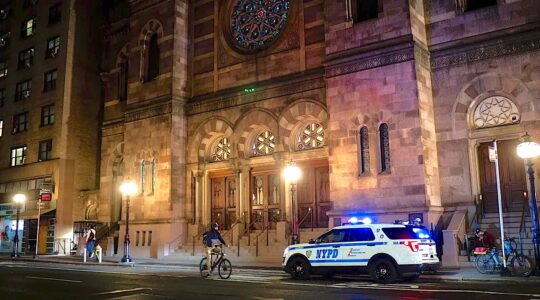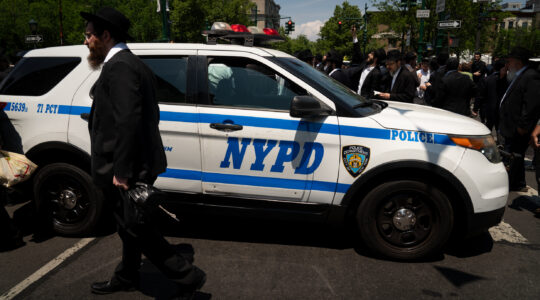You know the way a lot of Jews have a crush on Christmas trees? Here’s my confession: I have a crush on European Christmas markets.
I don’t actually want to buy a tiny, hand-painted wooden crèche, or a trumpeting angel figurine. I don’t need any handmade felt stockings to hang by my nonexistent fireplace.
But I do like shopping. I especially love shopping outside, at night, amid the lambent glow of holiday lights and the bustle of happy crowds in atmospheric Old World plazas. And if I can stroll around drinking glühwein — the hot mulled, spiced wine that takes the chill off a Northern European winter — so much the better.
Luckily, this year the Christmas and Chanukah shopping seasons overlap, giving us a perfect opportunity to browse the seasonal bounty (even if, let’s face it, all those sales weren’t set up with Chanukah in mind). For Europe travelers, it’s the ideal time to savor a long tradition of markets, holiday and otherwise — the kind of shopping that existed long before supermarkets sucked the charm out of the ritual.
Archetypal Old World emporia feature dozens of stalls run by vendors who chat with locals and tourists alike; wares are likely to include regional specialties, usually food but also books, holiday gifts and artisan handcrafts. Open-air or semi-enclosed, year-round or seasonal, markets typically offer refreshments (even sit-down cafés) along with ambiance.
In sunny Barcelona, mercats, as they are known in the local Catalan, are proud, elegant structures dating from the vaunted Modernist era of Spanish architecture — Art Nouveau to the rest of us. The most famous of these is the colorful, teeming Boquería, whose entrance sits midway down the famous Ramblas, and where shoppers browse everything from Mediterranean fish to Ecuadorean candy.
But many of the city’s other markets, long neglected, have been restored to their original role as neighborhood commercial hubs. Two of the best are the Mercats of Gràcia, an uptown district, and the beach quarter of Barceloneta; both markets offer soaring, distinctively Catalan architecture amid a lively central plaza. Inside, enjoy a café con leche or tapas and shop gourmet gifts like olive oils, spices, roasted almonds and chocolates.
In Florence, Italy, despite a reputation for cuisine and leather goods, many tourists never make it to the Mercato Centrale. Perhaps that’s because it’s not quite as central as the name would suggest; the city’s premier food market is about a 15-minute walk north or west from the Ponte Vecchio and the Florence synagogue.
But after a much-needed facelift a few years ago, the cafés and food stalls of the light-filled Mercato became Florence’s go-to spot for a fresh, tasty lunch or aperitivo. Just outside, the stalls of Mercato San Lorenzo fill a narrow, pedestrian-thronged alley with the bright and dark of Florentine shopping: plenty of leather handbags and wallets, plenty more made-in-China schlock, not-quite-bargain prices … and a vivid street scene that ensures your purchase, deal or not, is memorable.
In Eastern Europe, harsh winters push many year-round emporia indoors. One favorite is Budapest’s Great Market Hall, whose architecture boasts elements of Neo-Gothic, Moorish Revival, and a style I can only describe as European Train Station. On the fragrant first floor, shop for gourmet paprika and other spices along with fresh food; upstairs are wooden toys, hand-woven lace and linens.
In Sofia, Bulgaria, I have happily shopped my way along Graf Ignatief, one of the oldest and tastiest streets in the Bulgarian capital. Amid the rumble of Soviet-era streetcars, produce stalls serve hot chestnuts and steamed pumpkin in winter, raspberries in summer. On a central plaza, the open-air book market has vintage titles in dozens of languages; just beyond are good deals on wool rugs, embroidered tablecloths and semiprecious stone jewelry.
Scandinavia is a paradise for wintertime shopping, weather notwithstanding. One of the newest hotspots is Copenhagen’s Torvehallerne, a covered market that opened just five years ago and quickly became a social hub — beloved as much for its laid-back picnic scene on the plaza outside as for the tasty selection within. You’ll find everything from fish to flowers, spices to fine wines and liquors, even a microbrewery.
Support the New York Jewish Week
Our nonprofit newsroom depends on readers like you. Make a donation now to support independent Jewish journalism in New York.
For years, Berlin used to boast the only real Chanukah market in Europe, sponsored annually by the Jewish Museum. I’m not sure why it went on hiatus, considering the growth of Berlin Jewry and German enthusiasm for holiday shopping, but a consolation prize is the sixth floor at the Kaufhaus des Westens.
While KaDeWe, as locals call it, is technically a department store, the market spirit — and the inspiration for Manhattan’s food-hall trend — is alive on the legendary top floor. The Winter Garden comes with glass-walled views over the twinkling winter city, along with a smorgasbord of 35,000 gourmet items, from champagne to schnitzel. Elsewhere in the store, boutiques like Idee (colorful craft items) and Koko Von Knebel (luxury pet accessories) offer plenty of holiday inspiration — especially when it’s too cold to shop outside.
The New York Jewish Week brings you the stories behind the headlines, keeping you connected to Jewish life in New York. Help sustain the reporting you trust by donating today.




